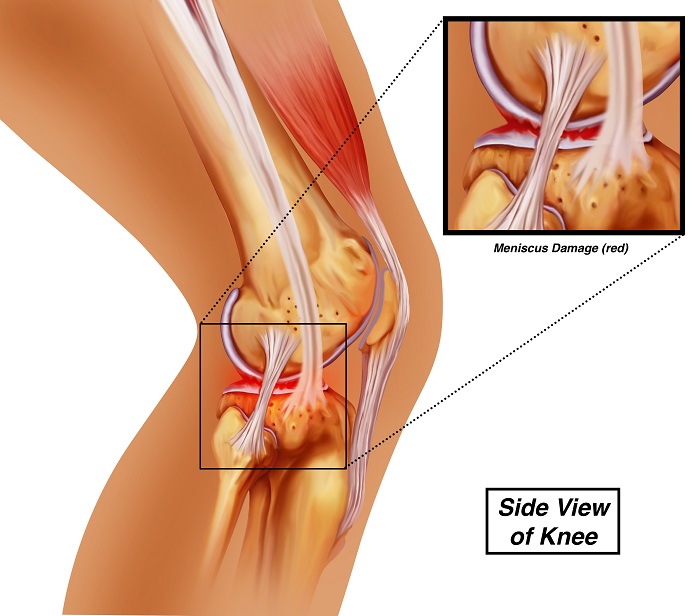PAIN ON THE SIDE OF YOUR KNEE
ILIOTIBIAL BAND SYNDROME

WHAT IS IT?
The iliotibial band (ITB) runs down the outer thigh to help stabilize the hip and knee. It is a small structure that gets overwhelmed easily.
SYMPTOMS
ITB syndrome usually causes dull or sharp pain on the outer side knee just behind the kneecap and above the joint line. There can be a painful click with knee bending.
What else could it be: Pain in the outer knee can also come from kneecap, meniscus, or shinbone issues.
TREATMENT
In additional to the usual treatments, IT band stretching can be extremely helpful. PT is very important to strengthen the hips to take stress over the ITB. Foam rolling may help but should be used with caution, only once or twice a week.
MENISCUS INJURIES IN RUNNERS

WHAT IS IT?
The meniscus is tough cartilage tissue that protects the bones and absorbs shock in the knee joint. When the meniscus gets torn and wears down, the knee becomes loses its ability to handle physical stress.
WHY DOES IT GET INJURED?
The meniscus can get damaged with constant repetitive sports stress, especially with running, twisting, kneeling, and pivoting.
Tears, thinning, fraying, and shredding can occur. The loss of intact cartilage makes sports difficult.
SYMPTOMS
Depending on the type of tear and overall cartilage damage, symptoms can vary. There may be mild to severe pain in the side of the joint with walking, running, kneeling, twisting, etc. Large, discrete meniscus tears have fragments that get caught in the joint, causing sharp pain, swelling, and loss of motion.
WHAT ELSE COULD IT BE?
Patellofemoral syndrome (kneecap), stress fracture, bone collapse, pes tendinitis and IT band syndrome can mimic meniscus pain.
TREATMENT
Once your doctor does testing to determine the type and extent of the damage, meniscus surgery may be recommended. When the damage is beyond a surgical remedy, your doctor can attempt to resolve meniscus pain with medications, injections, and physical
therapy. Regardless of treatment, meniscus tears may prevent a return to running.
OTHER CAUSES OF PAIN ON THE SIDE OF THE KNEE
- PES TENDINITIS: there are muscles from the thigh and groin form a tendon that inserts into the inner knee at the tibia (bigger shinbone) that can become inflamed with running. Bursitis can occur if the inflammation worsens. There will be mild tenderness below the joint line in the upper tibia, with some localized swelling, worse with running. Pes tendinitis is very treatable with the usual medical but we find that proper stretching, core stability, and running modifications can be very helpful.
- HAMSTRING TENDINITIS: the biceps femoris hamstring tendon attaches on the outer knee in the fibula (smaller shinbone). There is pain and tenderness usually felt with repetitive activities that stress the tendon out, in the outer knee towards the back. This is another very treatable condition that should resolve with rest, icing, running modifications, and physical therapy.
- OSTEOARTHRITIS is a condition where the protective lining in your knee has worn out in a way that cannot be replaced or repaired. This is what people mean when they say “my knee is shot”. Without protection, the knee joint cannot withstand much stress, especially with a high-impact sport like running. There will be activity-related pain on either or both sides of the knee, with stiffness, loss of motion, and swelling. Most people with osteoarthritis will have to stop running otherwise the knee will remain painful and will worsen over time. Osteoarthritis can be treated with medical treatments such as medications, injections, and knee replacement surgery, but none of these treatments is designed to maintain a running program. Regenerative procedures have been used to try to slow the knee’s aging process but results are questionable to date.
- BONE INJURIES can occur wwith excessive running. Serious dmage occurs tobone structure, ranging from bruise-like inflammation to fractures (breaks) in the bone. In extreme cases, part of the bone can collapse. There can be incomplete healing and permanent loss of function with these injuries. The femur (thighbone) or shinbone (tibia) can develop a bone injury. There will be extreme pain with weightbearing, and running becomes impossible. The pain can vary in location, but these injuries typically occur at the joint so the pain will often be on either the inner or outer side of the knee.
RECENT BLOG POST
TAPING YOUR INJURIES!
Taping has long been used by physical therapists and athletic trainers to treat various sports-related musculoskeletal injuries. Kinesiology taping is a modernized method of taping, popularized by its
